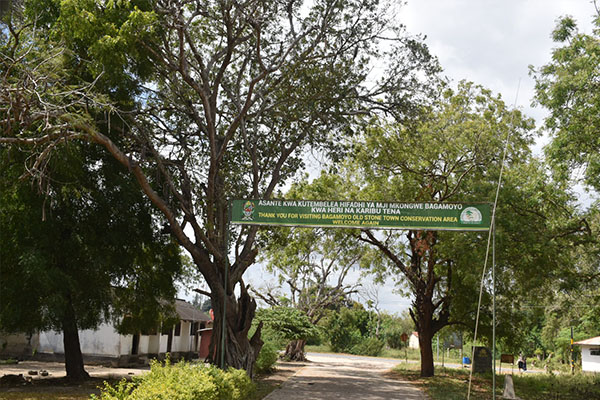BAGAMOYO
Bagamoyo
Loosley explains the meaning of the word Bagamoyo (“Bwaga-Moyo”) from Kiswahili is “lay down your heart”. Either the name might have been given due to the slave trade that passed through the city (“give up all hope”). Or because of the porters who rested in Bagamoyo after carrying 35 pounds of cargo from the Great Lakes region on their shoulders (“unload and rest”).
The town of Bagamoyo – nominated as a UNESCO World Heritage Site – with roughly 100.000 citizen was once an important trading port and the capital of German East Africa. It was the stopover for the slave and ivory caravans who travelled from Lake Tanganyika to Zanzibar.
You can travel from Dar Es Salaam to Bagamoyo: 2 hrs by car and
from Saadani National Park to Bagamoyo: 4.5 hrs by car
Trade goods were first fish, salt and rubber and in the first half of the 19th century for ivory and the slaves.
Bagamoyo city was founded at the end of the 18th century. It is an extension of the much older settlement Kaole from the 8th century. Bagamoyo was even once the capital of German East Africa.
In the Kaole ruins are the remains of two mosques and 30 graves from the 13th century. Around the 17th century the settlement began to grow 2-3 miles north of Kaole. This area grew in prosperity in the 18th century. It got name Bagamoyo as an important station in the caravan trade (the name means “relief and rest”). Until the 18th century, it was a small trading centre where the majority of the population were fishermen and farmers
Many European explorers, including Richard Burton, Henry Morton Stanley and David Livingstone, began and ended their journeys here. In 1868 French missionaries founded Freedom Village in Bagamoyo as a shelter for freed slaves. For the rest of the century the town served as a stopover for missionaries travelling inland from Zanzibar. When the German Empire decided in 1905 to build a railway from Dar Es Salam to the interior, Bagamoyo’s importance began to decline and today Bagamoyo is a centre for the construction of dhow sailboats.
The government is working to preserve the colonial ruins in and around Bagamoyo and to revive the city. Bagamoyo’s tranquil pace and fascinating history make it a pleasant day or weekend trip.
Things to do in and around Bagamoyo
Bagamoyo town:
With its cobwebbed portals and crumbling German-era colonial buildings, central Bagamoyo is well worth exploration. The most interesting area is along Ocean Rd where you’ll find the old German boma, built in 1897, and Liku House, which served as the German administrative headquarters. On the beach is the German customs house (1895). At Bagamoyo’s port you can watch boat builders at work and a busy fish market. Further south is the mid-19th-century Old Fort.
Kaole Ruins:
Just southeast of Bagamoyo are these atmospheric ruins. At their centre are the remains of a 13th-century mosque, which is one of the oldest in mainland Tanzania and also one of the oldest in East Africa. It was built in the days when the Sultan of Kilwa held sway over coastal trade, and long before Bagamoyo had assumed any significance. Nearby is a second mosque, dating from the 15th century, and about 22 graves, many dating from the same period.
College of Art:
Located about 500m southeast of Bagamoyo along the road to Dar es Salaam is this renowned theatre and arts college, home of the national dance company. When school is in session there are occasional performances, and it’s usually possible to arrange drumming or dancing lessons. The annual highlight is the Bagamoyo Arts Festival, usually held around late September or October.
Catholic Museum:
About 2km northwest of town is the Catholic mission and museum, one of Bagamoyo’s highlights, with well-labelled displays from Bagamoyo’s heyday. In the same compound is the chapel where Livingstone’s body was laid before being taken to Zanzibar Town en route to Westminster Abbey. The mission dates from the 1868 establishment of Freedom Village and is the oldest in Tanzania.
Caravan Serai Museum:
This undistinguished museum has a small display documenting the slave trade. More interesting than the present museum is the site at which it is built, which was formerly the starting point for slave and trade caravans to the interior.
The best time to visit is between the months of June through October because this is the dry season when rainfall is almost non-existent. At this time, the skies are clear and the waters of the sea are a stunning sapphire blue with contrasting azure. The annual highlight is the Bagamoyo Arts Festival, usually held around late September or October.
Photos from Bagamoyo





INQUIRE BAGAMOYO TOUR
Start planning your Bagamoyo tour by filling the form below
